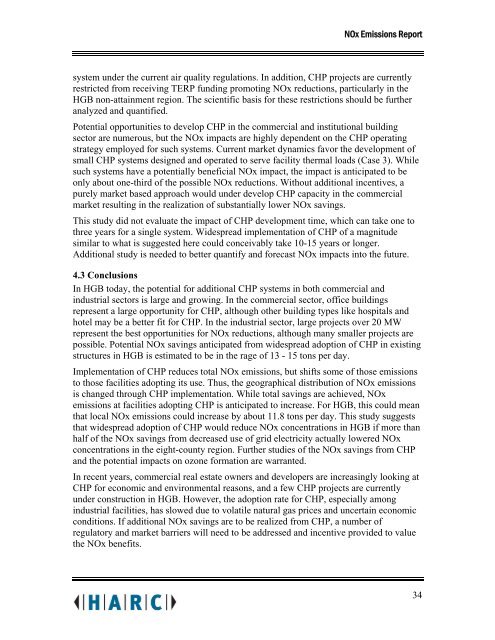NOx Emissions Impacts from Widespread Deployment of CHP in ...
NOx Emissions Impacts from Widespread Deployment of CHP in ...
NOx Emissions Impacts from Widespread Deployment of CHP in ...
You also want an ePaper? Increase the reach of your titles
YUMPU automatically turns print PDFs into web optimized ePapers that Google loves.
<strong>NOx</strong> <strong>Emissions</strong> Report<br />
system under the current air quality regulations. In addition, <strong>CHP</strong> projects are currently<br />
restricted <strong>from</strong> receiv<strong>in</strong>g TERP fund<strong>in</strong>g promot<strong>in</strong>g <strong>NOx</strong> reductions, particularly <strong>in</strong> the<br />
HGB non-atta<strong>in</strong>ment region. The scientific basis for these restrictions should be further<br />
analyzed and quantified.<br />
Potential opportunities to develop <strong>CHP</strong> <strong>in</strong> the commercial and <strong>in</strong>stitutional build<strong>in</strong>g<br />
sector are numerous, but the <strong>NOx</strong> impacts are highly dependent on the <strong>CHP</strong> operat<strong>in</strong>g<br />
strategy employed for such systems. Current market dynamics favor the development <strong>of</strong><br />
small <strong>CHP</strong> systems designed and operated to serve facility thermal loads (Case 3). While<br />
such systems have a potentially beneficial <strong>NOx</strong> impact, the impact is anticipated to be<br />
only about one-third <strong>of</strong> the possible <strong>NOx</strong> reductions. Without additional <strong>in</strong>centives, a<br />
purely market based approach would under develop <strong>CHP</strong> capacity <strong>in</strong> the commercial<br />
market result<strong>in</strong>g <strong>in</strong> the realization <strong>of</strong> substantially lower <strong>NOx</strong> sav<strong>in</strong>gs.<br />
This study did not evaluate the impact <strong>of</strong> <strong>CHP</strong> development time, which can take one to<br />
three years for a s<strong>in</strong>gle system. <strong>Widespread</strong> implementation <strong>of</strong> <strong>CHP</strong> <strong>of</strong> a magnitude<br />
similar to what is suggested here could conceivably take 10-15 years or longer.<br />
Additional study is needed to better quantify and forecast <strong>NOx</strong> impacts <strong>in</strong>to the future.<br />
4.3 Conclusions<br />
In HGB today, the potential for additional <strong>CHP</strong> systems <strong>in</strong> both commercial and<br />
<strong>in</strong>dustrial sectors is large and grow<strong>in</strong>g. In the commercial sector, <strong>of</strong>fice build<strong>in</strong>gs<br />
represent a large opportunity for <strong>CHP</strong>, although other build<strong>in</strong>g types like hospitals and<br />
hotel may be a better fit for <strong>CHP</strong>. In the <strong>in</strong>dustrial sector, large projects over 20 MW<br />
represent the best opportunities for <strong>NOx</strong> reductions, although many smaller projects are<br />
possible. Potential <strong>NOx</strong> sav<strong>in</strong>gs anticipated <strong>from</strong> widespread adoption <strong>of</strong> <strong>CHP</strong> <strong>in</strong> exist<strong>in</strong>g<br />
structures <strong>in</strong> HGB is estimated to be <strong>in</strong> the rage <strong>of</strong> 13 - 15 tons per day.<br />
Implementation <strong>of</strong> <strong>CHP</strong> reduces total <strong>NOx</strong> emissions, but shifts some <strong>of</strong> those emissions<br />
to those facilities adopt<strong>in</strong>g its use. Thus, the geographical distribution <strong>of</strong> <strong>NOx</strong> emissions<br />
is changed through <strong>CHP</strong> implementation. While total sav<strong>in</strong>gs are achieved, <strong>NOx</strong><br />
emissions at facilities adopt<strong>in</strong>g <strong>CHP</strong> is anticipated to <strong>in</strong>crease. For HGB, this could mean<br />
that local <strong>NOx</strong> emissions could <strong>in</strong>crease by about 11.8 tons per day. This study suggests<br />
that widespread adoption <strong>of</strong> <strong>CHP</strong> would reduce <strong>NOx</strong> concentrations <strong>in</strong> HGB if more than<br />
half <strong>of</strong> the <strong>NOx</strong> sav<strong>in</strong>gs <strong>from</strong> decreased use <strong>of</strong> grid electricity actually lowered <strong>NOx</strong><br />
concentrations <strong>in</strong> the eight-county region. Further studies <strong>of</strong> the <strong>NOx</strong> sav<strong>in</strong>gs <strong>from</strong> <strong>CHP</strong><br />
and the potential impacts on ozone formation are warranted.<br />
In recent years, commercial real estate owners and developers are <strong>in</strong>creas<strong>in</strong>gly look<strong>in</strong>g at<br />
<strong>CHP</strong> for economic and environmental reasons, and a few <strong>CHP</strong> projects are currently<br />
under construction <strong>in</strong> HGB. However, the adoption rate for <strong>CHP</strong>, especially among<br />
<strong>in</strong>dustrial facilities, has slowed due to volatile natural gas prices and uncerta<strong>in</strong> economic<br />
conditions. If additional <strong>NOx</strong> sav<strong>in</strong>gs are to be realized <strong>from</strong> <strong>CHP</strong>, a number <strong>of</strong><br />
regulatory and market barriers will need to be addressed and <strong>in</strong>centive provided to value<br />
the <strong>NOx</strong> benefits.<br />
34
















